I went to a women’s festival on Lesvos – this is why you need to add it to your travel bucket list

The International Eressos Women’s Festival is a two-week holiday in a village where every event is put on by women, and for women (Getty/womensfestival.eu/Erresian.com)
I tell you/someone will remember us/in the future
These words are from a fragment of a lost work by Ancient Greek poet Sappho, who was so well-known for her lyrical poetry focusing on love and women, that her name, and the name of her home island, became derivatives of the terms sapphic and lesbian.
The poem speaks of the desire to be remembered well beyond the author’s life time – tragic in the context that so much of Sappho’s work is lost to the ages, but deeply empowering when we consider that we do remember her because of remaining fragments such as this.
For a poet who is widely considered to be “the first lesbian”, although debate about her sexuality in academic circles does continue, the words take on a different dimension. The longing for a relationship – perhaps one between women – to be recognised in its unashamed entirety.
For the vast majority of history, women who have loved other women in ways beyond the platonic lived in the shadows, their lives and love relegated to second-class citizenship and secrecy.
Heterosexual revisionism has meant lesbian relationships have been dismissed by historians as nothing more than deeply committed friendships (see: the Ladies of Llangollen, Emily Dickinson and Susan Gilbert) and written accounts of women’s same-sex sexual experiences censored (Anne Lister).
Even in ancient Greece, a culture where male homosexuality was ubiquitous, female sexuality was erased and invisible because of the patriarchal norms.
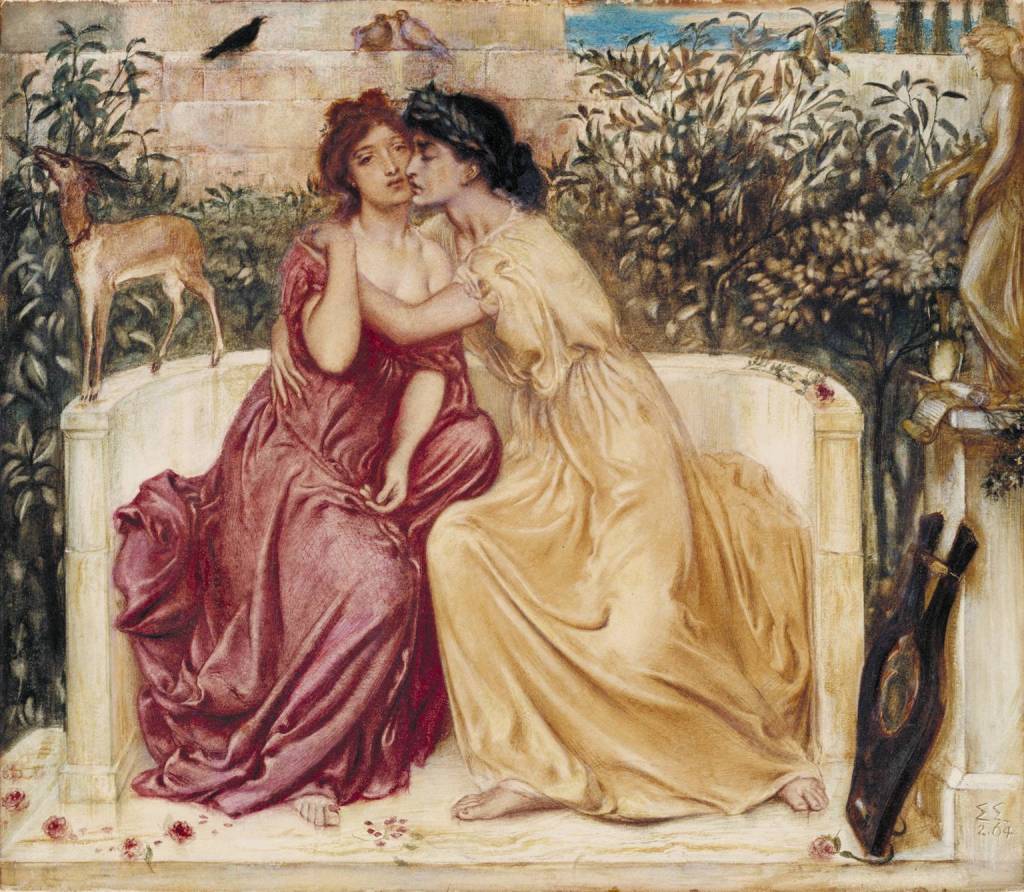
Even in modern times, nearly five decades after the Stonewall riots, women who love women face erasure.
Biphobia is rampant, femme lesbians are invalidated, and butches are often abused for walking through the world as “incorrectly female”, in the words of Hannah Gadsby. And, of course, we all still face those infuriating, deeply misogynistic and homophobic times when men ask us if “they can join in” and “who is the man?” Neither hun, that’s the point.
It also won’t come as news to any queer women that physical spaces featuring sapphic experiences have been in steep decline in recent years. While, in the UK at least, there has been an uptick in pop-up events and community groups, including Lick, Butch Please and Dykes Who Hike, permanent places such as bars and clubs where queer women can meet are now few and far between. So much so, that when La Camionera opened in East London, the first new lesbian in the capital for at least a decade, it was seen by many as a change in the tide.
It is for this reason that the annual, two-week International Eressos Women’s Festival focusing on the experiences and perspectives of women – notably lesbian, bisexual and queer women – on Sappho’s home island of Lesvos is a unique and vital space for building a sapphic community for the future.
Lesvos, or as many English-speakers know it, Lesbos, is the third-largest Greek island, behind Crete and Evia, and the festival takes place in the picturesque seaside village of Skala Eressos, close to where the poet is believed to have been born.
As a lesbian who has two English degrees, and loves to learn about Greek history, it has long been on my bucket list to visit the beautiful island that Sappho called home. Much like how people visit Shakespeare’s Globe to feel closer to the Bard, or stay in Bath to connect with Jane Austen, I wanted to walk along the beaches and cobbled streets of Lesvos, to get a sense of the world in which Sappho lived and – as her poetry touched on – the world in which she loved.
While I knew the festival would be jam-packed full of women-loving-women, I did not expect to feel such a deep sense of shared connection with those I didn’t know, from various different countries and some of whom were 40 years my senior.
From yoga classes to DJ sets, and scuba diving trips to hikes, the festival fits a lot into a fortnight, but, at its heart, it’s all about bringing women from different walks of life together in their diversity, to connect in friendship, learning and empowerment.
There was something very special about such a multi-dimensional space that gives a platform to women in every aspect, from those leading the sessions to the ones attending them. Like the queer women of millennia ago, we live in patriarchy and are so unconsciously used to that system that when I was removed from it – as I experienced at the festival – my eyes were opened to just how much we miss out on by not having spaces in our every-day lives where queer women can flourish in their entirety.
Nearly 3,000 years ago, Sappho mused about being remembered. A women’s festival focused on female love, friendship and connection named in her honour is pretty apt if you ask me, and the ongoing legacy of Sappho and the festival means, yes: someone will remember us in the future.
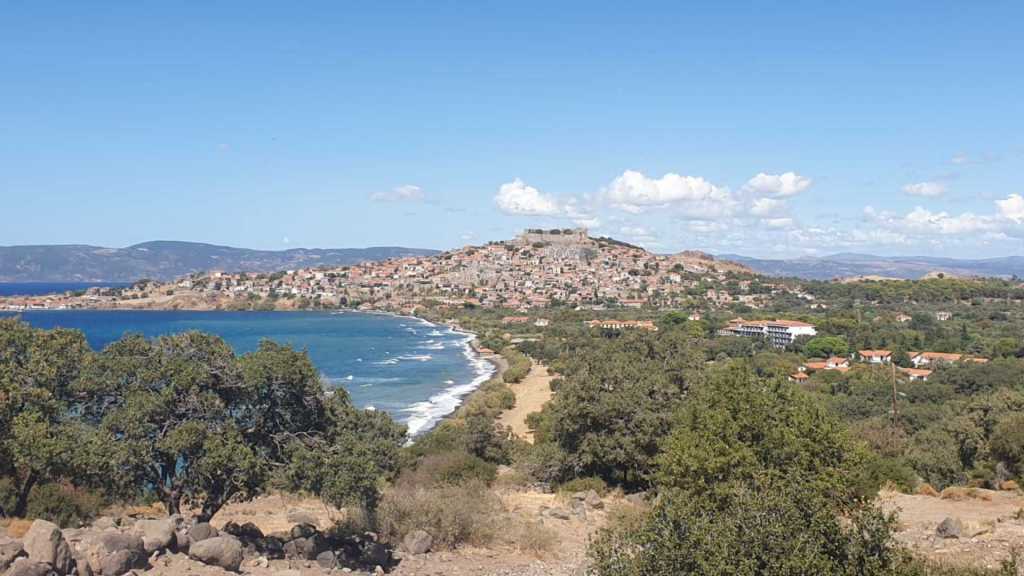
How I experienced Lesvos, and how you can too
As part of the trip, my flights were kindly provided by AEGEAN and I was a guest of discovergreece.com.
Eressian Hotel and Hammam Spa, Eressos
Located in the heart of the village of Eressos, in the south-west part of the island, the award-winning Eressian Hotel is a restored 1850s mansion. Built right next to it, Eressian Hammam & Spa is described as a “sanctuary of well-being” with a wide-range of treatments and services on offer.
The hotel earns its definition as “boutique” with just two suites, two rooms and a living room (alongside a pool, of course). It’s traditional design, combined with an open concept and bright, airy rooms (with incredibly high ceilings), certainly makes it feel as if you are staying in someone’s beautifully kept home.
It offers a wonderfully varied breakfast, including locally sourced products such as eggs, cheeses and breads. A stand-out dish for me was the Eressian eggs benedict: every individual element was fresh and flavoursome and made for probably the best I’ve ever eaten.
The hotel is less than a minute’s walk from the village square where there are restaurants, a little shop for essentials and a pharmacy. I dined at Kafene, and at Sam’s, and found both restaurants extraordinarily welcoming and the food packed with flavour – the calamari from the former was particularly enjoyable.
Just a seven-minute drive away is the gorgeous seaside village of Skala Eresou (Σκάλα Ερεσού), where much of the women’s festival takes place.
Isidoros Arvanitis distillery, Plomari
I was lucky enough to visit the Isidoros Arvanitis distillery in the picture-perfect village of Plomari, located on the island’s southern coast, to see where their ouzo is made.
Ouzo is dry anise-flavoured alcoholic aperitif which tastes of smooth liquorice and is popular throughout Greece. It is usually enjoyed with small plates of food such as olives, feta cheese or breads, although the notion of “going for an ouzo” is not to focus on the drink or the food but the people you are with.
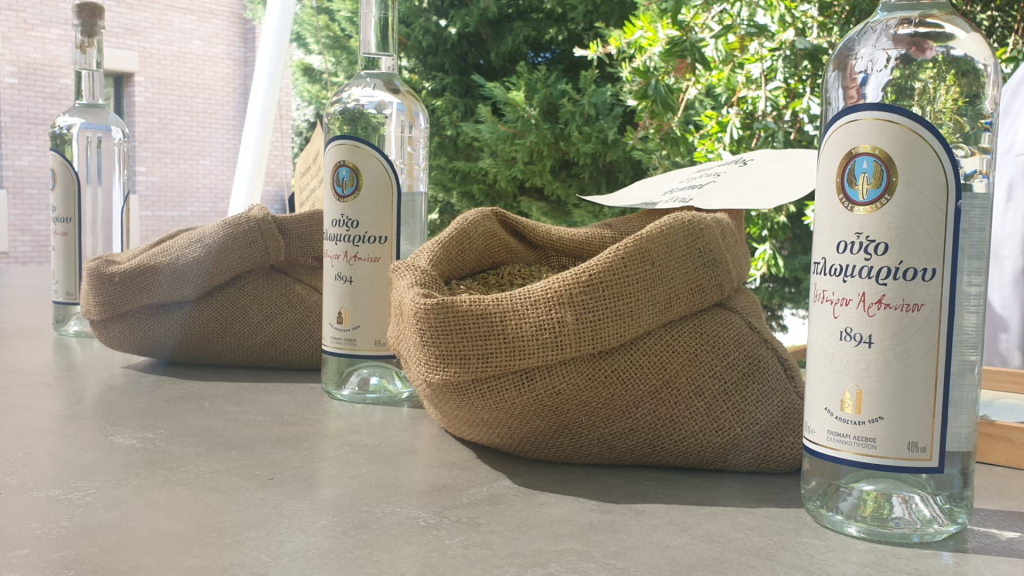
The spirit is not usually drunk neat but mixed with a small amount of water and/or ice, which turn the clear liquid a milky white colour. I have to be honest, I had never had ouzo before visiting the distillery, so effectively I went completely blind into tasting it, and learning about the culture it represents.
During the tour, we were shown the step-by-step process to produce ouzo, from the ingredients used, to the huge copper stills where the liquid is distilled, and the bottling process – thousands of bottles leave the distillery every day and are transported across the world.
It was an eye-opening experience and I came away with genuine insight.
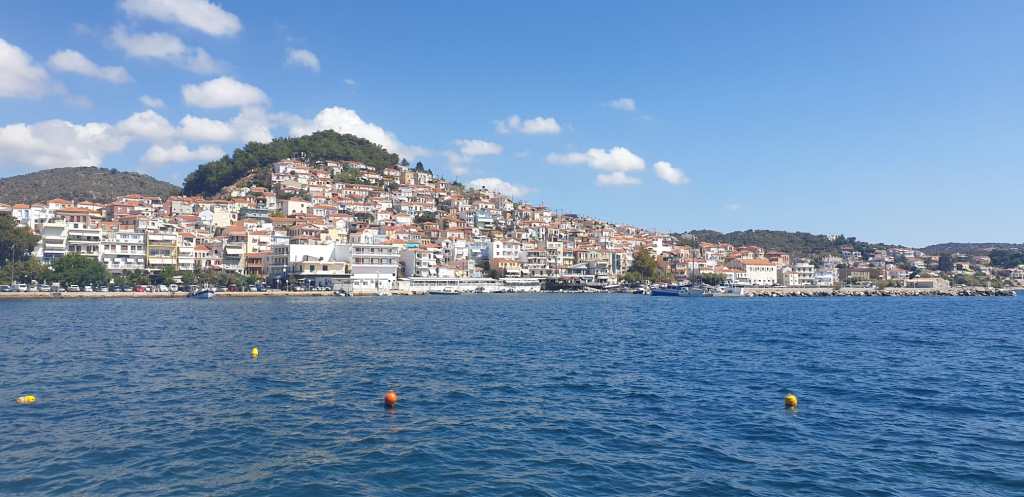
Admittedly, the distillery is quite a long drive from Eressos, only a little less than two hours, but do not be put off: given everything you learn about the drink and its place in Greek culture, I wholeheartedly recommend making a day of it. Afterwards, if you need a rest, you can always pop into Plomari itself which boasts a lovely little marina, small shops, cafes and restaurants with al-fresco dining, looking out over the water.
Sigri & Natural History Museum of the Lesvos Petrified Forest
Another picturesque point of interest is the fishing village of Sigri near the western tip of the island, which looks over the bay and the long island of Nissiopi, and is home to the Natural History Museum of the Lesvos Petrified Forest.
Much of my time in Sigri was spent in the museum and, as someone who is a fossil collector, was a fascinating few hours learning about the geological history of the island.
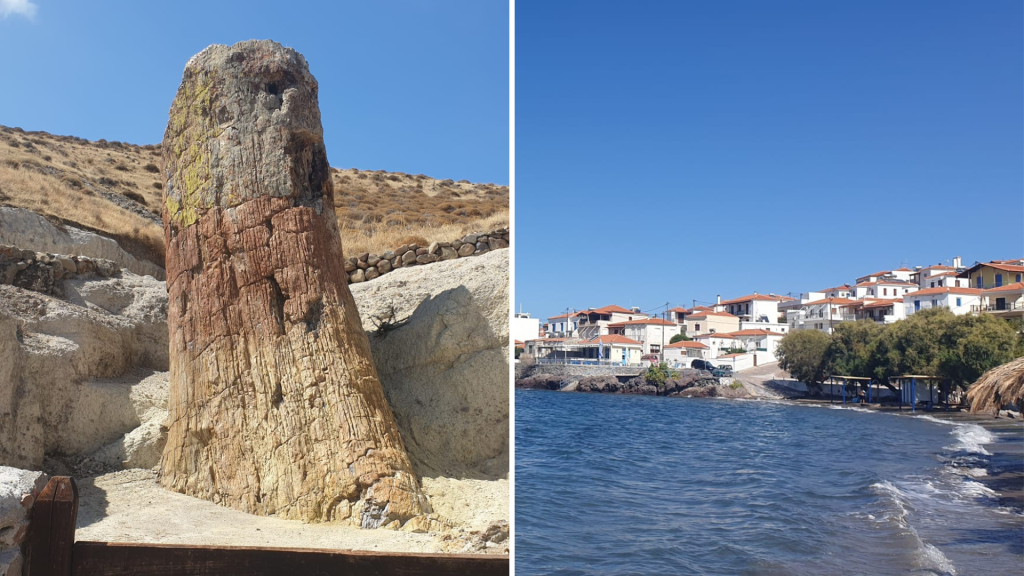
The museum is relatively small but is packed with information, and guides visitors through the evolution of life and the geological history of the region, showcasing fossilised plant and animal life, samples of minerals, and rocks.
The stand-out part of the museum, of course, is the unique forest. Many petrified trees can be seen within the its walls but to get a real sense of the scale of these huge examples, see them out where they stood millions of years ago, petrified in place by volcanic forces.
One tree, which is the tallest known standing trunk of a fossilised tree in Europe, can be found in the park, and towers over visitors at 7.02m (about 23ft) and is an ancestral form of the present-day the sequoia.
Petra and Mithymna
Two other areas you should visit are the towns of Petra and Mithymna – also known as Molyvos – on the north-western part of the island.
Both towns, nine minutes apart by car, are exactly what you hope to experience when you visit Greece, with friendly locals, pretty cobblestone streets lined with olive trees, classically designed homes, quaint restaurants and shops couched in shaded market squares.
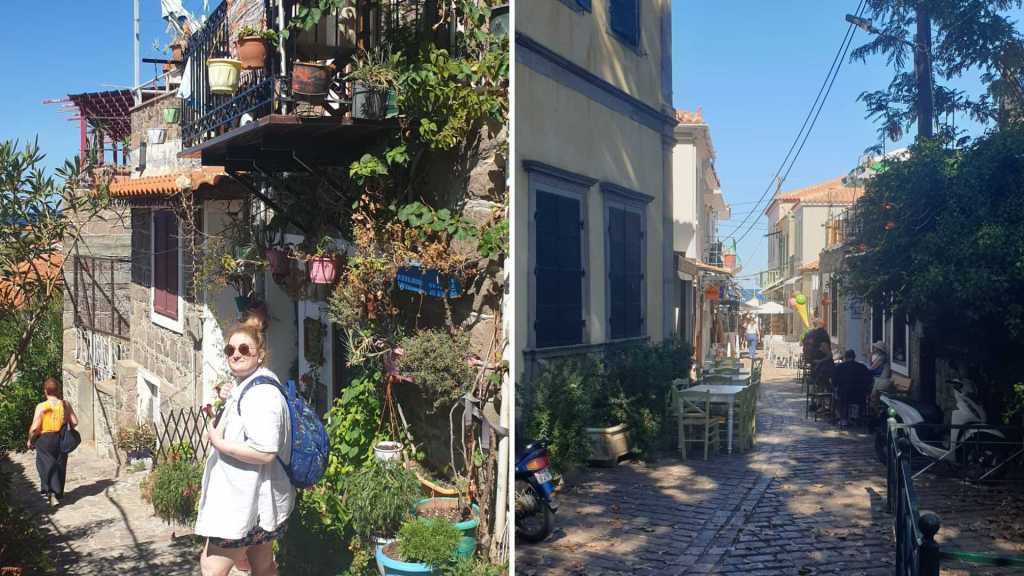
A sight to behold in Petra is the Holy Church of the Virgin Mary Glykophilousa, which is perched 40m (130ft) above the rooftops on a rocky outcrop in the centre of town. You’ll have to climb the 114 steps to reach the top, but when you do, you are treated to magnificent views across the town and beyond into the sea and hills.
Mithymna also has a sky-high point of note: the impressive castle of Molyvos which stands above the town and dates back millennia. From the castle, which is one of the top tourist attractions on the island, you are able to see across the Aegean Sea to the western tip of Turkey.
Making your way from the castle, you amble down winding cobbled streets shaded by wisteria, dip into colourful shops and stop at restaurants that have balconies looking out on to the coast, before reaching the harbour and beach.
The next International Eressos Women’s Festival: Sappho Women will be held from 7-20th September 2025.
Share your thoughts! Let us know in the comments below, and remember to keep the conversation respectful.
How did this story make you feel?

